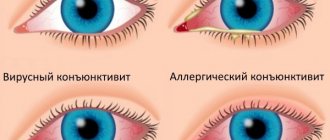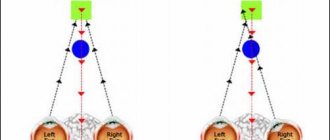External causes of burning
Rare burning symptoms that disappear within 1-2 hours or after sleep should not cause severe discomfort to a person. They may be accompanied by lacrimation, but even in this case, the culprit is most often working at the computer, excessive eye strain, or windy weather outside. If the problem occurs regularly, it requires treatment. In this case, non-pathological reasons, which do not depend on the state of internal organs and systems, may be the following:
- trauma to parts of the eye: hit by an object, blow, fall;
- infectious infection: viruses, bacteria, development of burning sensation due to influenza, conjunctivitis or ARVI;
- an allergic reaction to dust, pollen, fur and animal secretions is the most common cause of tearing and burning in the eyes;
- increased intraocular pressure, which develops as a result of diseases of the organs of vision;
- long stay in a room where there is a lot of smoking, or exposure to smoke directly into the eyes;
- retinal burns with steam or hot water, in other cases – with chemicals (household chemicals, hazardous industries);
- staying in a room with an air conditioner for a long time;
- other eye diseases, for example, glaucoma or cataracts in the early stages (not associated with infections and viruses);
- incorrectly selected contact lenses, as well as violation of the rules for wearing them;
- dry eye syndrome, or other factors that lead to a deterioration in the lubricating properties of the mucous membrane.
However, it is impossible to limit ourselves to only these factors. Doctors identify several groups of diseases that cause lacrimation and burning in the eyes.
Systemic pathologies
Systemic diseases most often include:
- hyperthyroidism is a pathology of the thyroid gland that causes disease of the visual organ, as well as exophthalmos;
- blood diseases, especially malignant lymphoma;
- autoimmune disorders, most often with burning and lacrimation, rheumatoid arthritis or scleroderma; See here: The first symptoms of rheumatoid arthritis in adults.
- Vasculitis, which affects the blood vessels of the eye, can cause the symptom;
- pemphigus and other skin pathologies often cause pain, including severe burning in the eyes;
- hormonal disorders also affect the health of the organ of vision, especially pronounced during menopause or pregnancy;
- Acute respiratory infections cause complications in the eyes.
Treatment of the disease should begin with a visit to an ophthalmologist. The doctor will determine whether there are any abnormalities in the condition of the eyes and will give recommendations for visiting other specialists to identify pathologies.
If eye symptoms are detected, treatment is usually symptomatic, but the underlying disease must be eliminated.
Allergy as a factor in symptoms
Conjunctivitis is one of the manifestations of an allergic reaction that occurs due to the penetration of an allergen into the mucous membrane. There is also a toxic-allergic lesion that develops against the background of inhalation of excessive amounts of household chemicals and other chemicals. Allergic manifestations are accompanied by:
- atopic or vernal keratoconjunctivitis; See here: how to determine the type of conjunctevitis.
- capillary conjunctivitis;
- Quincke's edema;
- eyelid dermatitis;
- hay fever conjunctivitis.
Allergies can also be caused by eye syndrome, which occurs due to overexertion, infections or systemic diseases. In any case, you first need to be examined by a doctor and undergo tests to make sure there are no deeper causes of the disease.
If the allergy is caused by incorrect lenses or problems with hygiene when wearing them, then the symptoms include: clear discharge, itching, swelling of the eyelids.
Dry eye syndrome
Pathology very rarely develops as an independent disease; it is most often preceded by a long course of other diseases or exposure to external factors. Additionally, with dry eye syndrome, a person notes: itching, burning, redness, foreign body sensation.
One of the causes of pathology is too dry air in the room. Some note that dry eye syndrome develops mainly in autumn and winter. Symptoms appear in the morning and become much stronger in the evening. If the condition is not treated, filamentous keratitis develops, and the patient’s well-being worsens. To prevent the condition, it is necessary to use drugs or artificial tear substitutes that moisturize the membrane of the organ of vision.
Causes
If your eyes feel like there is sand in your eyes, you should determine the cause of this phenomenon. The organ of vision is covered with a protective tear film, which is responsible for hydration. When blinking, tears are distributed evenly over the surface of the mucous membrane. It often protects the eyes from foreign objects. But sometimes this may not be enough.
Due to various reasons, the tear layers can become thinner. Against this background, drying out and tissue nutritional deficiency may develop. This causes a feeling of sand in the eyes. The reason may lie in the development of pathological processes or physiological factors.
The main reasons for the occurrence of such unpleasant symptoms:
- incorrectly selected contact lenses, first use of such products or their low quality;
- Excessive strain on vision – long periods of working at the computer, watching TV, reading;
- exposure to strong wind or dry air on the eyes;
- influence of sunlight;
- adverse reactions due to taking ophthalmic medications;
- getting water with impurities of chemical elements into the eyes (from the water supply or swimming pool), especially chlorine, which irritates the mucous membranes;
- overwork, constant lack of sleep;
- hormonal changes (mainly occur in women during pregnancy and menopause);
- age-related changes.
Elderly patients often experience these symptoms. The reason lies in the development of irreversible processes. Local metabolic processes are also disrupted and oxygen supply is reduced.
Patients whose work activities involve contact with chemicals and household substances are at risk. Sometimes minor burns can cause unpleasant symptoms. At the same time, the eyes hurt and redness appears. The patient needs medical attention.
Sometimes the cause of the feeling of sand in the eyes can occur due to a minor injury. For example, damage to the mucous membrane by metal particles. Pain, burning, and redness appear. Sometimes such particles can come out of the eyes on their own along with tears. But if it damages the membrane, then the help of an ophthalmologist will be required.
Diagnostics
When a person complains of redness and burning in the eye, the ophthalmologist finds out the factors causing the problem and conducts an examination using side lighting.
For a more in-depth examination, the doctor examines the organ of vision using a slit lamp (biomicroscopy) and an ophthalmoscope (ophthalmoscopy).
If there is discharge, bacterial culture is performed to assess the nature of the microflora and determine sensitivity to antibiotics.
Burning, at first glance, is an insignificant symptom. But it can cause serious complications: decreased visual acuity, even blindness. What to do when your eyes are watery and burning? Preparations:
- "Floxal", antibacterial drops or ointment. Used for infectious causes. Dosage of drops: 1 drop, 2–4 times a day. Ointment dosage: 1.5 cm of ointment behind the lower eyelid, 2–3 times a day. Course up to 2 weeks.
- Instillation of “Ophthalmoferon” - drops with anti-inflammatory, immunomodulatory, regenerating effects, and antiviral activity. Prescribed to relieve irritation in viral diseases. Recommended dosage: 1–2 doses, 6–8 times a day, as inflammation subsides, 2–3 times a day.
- Taufon drops based on taurine improve metabolic processes in cells and healing. Recommended for overwork of the visual organ, injuries, dystrophic processes that cause burning. Instill 1–2 drops, 2–4 times a day. Use drops until cure, but no more than 3 months.
- Visine, an alpha-adrenergic agonist. Relieves redness and burning caused by exposure to smoke, wind, cosmetics, and lenses. Effective for allergic reactions. Instill 1–2 drops, 2–3 times a day.
- “Artificial tears” – moisturizing drops. They have a good effect on dry eye syndrome. Directions for use: instill 1-2 drops, 4-8 times a day.
- Allergodil drops will relieve the symptoms of burning and redness due to allergies. 1 dose 2 times a day until symptoms subside.
How to treat burning and lacrimation with traditional recipes? You will always have regular tea, chamomile, and potatoes on hand:
- Black tea. Brew tea without flavorings, cool to warm temperature. Soak cotton pads and apply to eyelids for 15 minutes. You can use tea bags.
- Chamomile. The same method, only using chamomile.
- Potato. Cut raw potatoes into slices and place them on closed eyelids for 15 minutes.
If your eyes hurt, burning, redness, or a feeling of sand - this is a signal when you need to go to the doctor. Wasting time on unsuccessful self-medication can cost you your sight.
Tests and diagnostics
Many people prefer not to go to the hospital, preferring to deal with the problem using traditional methods or medications that helped their friends in a similar situation. This approach can only be justified if the person knows exactly the cause of the deterioration in well-being. In most cases, this can only be determined with the help of instrumental and laboratory examinations, so the best option for such symptoms would be to contact an ophthalmologist.
Diagnostic features
To make an accurate diagnosis, the patient is prescribed the following diagnostic complex:
- examination of tear secretion to identify nutrient media and pathogenic flora;
- tubular and nasal tests that help assess the volume of tear fluid production (Schimmer test);
- measurement of intraocular pressure;
- staining the cornea with a fluorescein solution to identify its pathologies and damage;
- ophthalmoscopy (examination of the fundus of the eye using an ophthalmoscope or fundus lens).
Ophthalmoscopy
Depending on the diagnosis, the patient will be prescribed the necessary treatment, as well as recommendations for the prevention of complications.
Burning in the eyes. Causes and treatment
Treatment for burning eyes mainly depends on the cause that led to this symptom.
Burning eyes are a sensation of burning and dryness in the eyes. Very often, a burning sensation is a symptom of serious problems in the eyes.
Symptoms of burning eyes
Burning eyes may be accompanied by other eye symptoms, including:
- discharge from the eyes - feeling of dryness of the eyes - itching and burning in the eyes - redness and pain in the eyes - pain, lacrimation and photophobia - blurred vision
Causes of burning eyes
There are the following reasons for the appearance of this symptom:
1. Environmental reasons. Most often, the symptom of burning in the eyes is caused by aggressive environmental influences:
- strong wind - dust or smoke - intense sun exposure - smog - chemical irritants (soap, makeup remover, cosmetics, etc.)
Causes related to allergies
- pollen - mold - fungus, fungal spores - animal dander
2. Ocular causes
- dry eye syndrome - inflammation of the mucous membrane of the eye (conjunctivitis) - inflammation of the skin of the eyelids (blepharitis) - inflammation of the cornea (keratitis) - chronic meibomitis - Sjögren's syndrome - wearing contact lenses
3. Other reasons
- old age - taking certain medications
When should you see a doctor urgently?
- if the burning sensation in the eyes is accompanied by pain or increased sensitivity to light and watery eyes - if you have any discharge from the eyes - if along with the burning sensation there is deterioration or blurred vision
Even if you do not have any of the listed symptoms, but have a burning sensation in your eyes, you should consult a specialist.
How to treat burning eyes
Treatment for burning eyes mainly depends on the cause that led to this symptom.
In case of exposure to negative environmental factors, it is necessary to first avoid such situations. Cold compresses with chamomile decoction will help quickly relieve the symptoms of burning around the eyes, in case of environmental causes.
In case of allergies, the doctor prescribes antiallergic medications that minimize the occurrence of burning sensation in the eyes.
Burning eyes with dry eye syndrome go away with the use of moisturizing drops. It is often necessary to use artificial tears that do not contain preservatives.
What should you absolutely not do?
If a burning sensation occurs in the eyes, you should not:
- rub your eyes, this increases the burning symptoms - instill eye drops without a doctor's prescription - wear contact lenses
What happens if the symptom is not treated?
A burning sensation in the eyes caused by environmental reasons can go away on its own without consequences for your vision and health.
In other cases, treatment of the underlying disease that leads to the development of this symptom is necessary.
Prevention
Here are some tips to help you avoid burning eyes:
— Visit your eye doctor regularly to ensure early diagnosis of conditions that may be causing the burning sensation. — If you wear contact lenses, tell your eye doctor about the symptoms of burning sensation. — Wear eye protection (dark glasses, masks, goggles) when exposed to adverse conditions. environmental factors.—If you suffer from a condition that causes a burning sensation (such as dry eye syndrome), use moisturizing drops to reduce symptoms.—Never ignore new symptoms or sensations that occur in your eyes.
Come for diagnostics at the address: Almaty, Tole bi street, 95a (corner of Baitursynov street).
Telephone;
When to see a doctor urgently
- If the feeling of sand in the eyes occurs when you are in a dusty room, after a strong wind, or you suspect the presence of a foreign object in the eye
- You wear contact lenses and the feeling of sand in your eyes increases after putting on contact lenses
- The feeling of sand in the eyes bothers you in the morning and gets worse in the evening
- A feeling of sand in the eyes accompanied by pain or increased sensitivity to light and watery eyes and blurred vision
What can trigger the symptom
Causes of burning eyes that are not associated with any ophthalmological diseases may be as follows:
- Climate. After swimming in salty sea water, working in a field or open area under the scorching sun, or in a strong wind, the eyes often burn, itch and turn red. In hot weather, the cornea dries out, which can also cause discomfort.
- Ecology. Residents of large cities, workers of chemical plants, or people living near hazardous enterprises often have burning eyes, headaches, and dry noses. All this is exposure to smog or toxic chemical fumes.
- Cosmetics. If not only the eye itself is red and itchy, but also the skin around the eyes, perhaps it’s all because of a new soap that doesn’t suit you, makeup remover milk, or decorative cosmetics. It’s not difficult to track reactions to cosmetic products: you just need to completely exclude everything for a few days, and then test them one by one.
- Allergy. Manifestations of allergies are similar to a reaction to an unfavorable environmental situation: mucous membranes dry out and become irritated, tears flow profusely, sneezing and coughing occur, and headaches may bother you. Symptoms appear upon contact with an irritant allergen - pets, pollen, mold, etc.
- Entry of foreign bodies. Dust, sand, hairs, and other small particles that come into contact with the mucous membrane of the eye injure it and cause severe irritation and burning.
Note: often builders' eyes hurt and itch after welding, working with paints and varnishes, or mineral wool. You should definitely use a protective mask and goggles at work, and it wouldn’t hurt to purchase moisturizing and protective eye drops for regular use. If the symptom does not go away, it makes sense to change profession - constant inflammation of the conjunctiva can lead to the development of very serious pathologies, including loss of vision and disability.
What treatment is prescribed
Effective drugs
Visine has a moisturizing effect, eliminating dryness and redness.
If sand in the eyes syndrome begins to bother you due to excessive dryness of the mucous membrane, the doctor selects special eye drops for dryness. The following drugs have a moisturizing effect:
- "Vial";
- "Artificial tear";
- "Vizin";
- "Hypromellose";
- "Systane";
- "Lakrisifi";
- "Hilo Chest of Drawers."
When pain, burning and discomfort are symptoms of an infectious-inflammatory disease, the following groups of medications are prescribed:
- antibacterial;
- antiseptic;
- non-steroidal anti-inflammatory drugs;
- glucocorticosteroids;
- antiviral eye drops;
- antihistamines;
- hyposensitizing;
- regenerating;
- vitamin and mineral complexes.
Treatment with folk remedies
Effective folk remedies for eliminating itching and redness include a compress of chamomile, string and calendula.
Alternative medicine will help get rid of sandy eyes and itching, but before you start using them, you need to visit a doctor and agree on a treatment regimen with him. Effective traditional medicines are:
- Compress based on bactericidal infusion. Combine chamomile, string and calendula flowers in equal proportions. Separate 1 tbsp from the mixture. l. and pour 250 ml of boiling water over it. Let the product sit for 20 minutes, then strain. Soak cotton pads in the infusion and apply to the eyes. It is recommended to make such a compress daily, at least 3-4 times a day.
- Anti-inflammatory drops. Boil water (300 ml), add chopped marshmallow root into it. Bring the product to a boil, turn off the heat and simmer for another 10 minutes. Afterwards, let it sit until the liquid cools to body temperature, strain through gauze folded in 4 layers. Place 3 drops of the decoction into both eyes.
- Restoring honey ointment. Mix 2 tbsp. l. liquid honey with 1 spoon of strained aloe juice. Using a syringe, place the ointment under the eyelid, then massage with your fingers, evenly distributing the medicine over the mucous membrane.
How to treat
You can begin treatment only after accurately determining the cause. To make a diagnosis, a doctor simply needs to examine the patient. Only in some cases will he take a sample from the surface of the organ of vision. Both pharmacy and home medicines can be used for treatment.
Useful information on the topic! How the disease progresses and how to properly treat it.
To eliminate pain in the eyes, the following ointments can be used:
The following eye drops are considered effective:
If there is a viral infection of the eyeball, then it is worth using Oftalmoferon. It can be used for children and adults. Drop 2 drops into each eye 3 times a day. It has no contraindications or side effects.
But what other drops can be used in the eyes for dryness and pain, this will help you understand
Folk remedies
With the help of folk remedies, you can only stop the symptoms, but not eliminate the cause. So they should be used in combination with medications. The following recipes remain effective:
- Cucumber juice
. If an unpleasant symptom occurs due to fatigue or tension, then you can make cucumber lotions. It perfectly relieves swelling, irritation and wrinkles. - Honey.
Add 3 potassium flax oil to 20 g of honey. Place the mixture on your eyelids and hold for 15 minutes. After the first procedure, fatigue and soreness go away. - Cheremsha
. Take 10 g of raw material and add 200 ml of hot water. Leave for 8 hours, filter, dip cotton pads and apply to eyes. Keep for 20 minutes. Perform activities 2-3 times a day. - Marshmallow root
. To treat conjunctivitis, you can take 60-80 g of finely chopped marshmallow root and pour 200 ml of boiling water. Leave for 8 hours, filter, dip cotton pads and apply to eyes. Keep for 15 minutes. Carry out similar actions 2 times a day. - Chamomile.
This plant has a powerful calming and anti-inflammatory effect. You need to take 30-60 g of chamomile, pour a glass of boiling water. Leave for 20 minutes, filter and use to wash eyes.
Pain in the eyes is a symptom that may indicate various pathologies affecting the visual apparatus. The sooner the cause is determined, the sooner the doctor will be able to prescribe treatment, and the patient will be able to get rid of unpleasant symptoms.
Stinging of the eyes does not happen without a reason; certain factors and problems in the body contribute to irritation. Some we can independently determine, for example, shampoo getting into the eyes, when it is enough to simply rinse the mucous membrane well, and the problem will be solved.
Important! In some cases, such as ophthalmic diseases, you cannot do without the help of specialists
Price of eye drops to eliminate the feeling of sand in the eyes
We looked at several types of eye drops that are most often prescribed for dry eye syndrome. But many patients are concerned about the cost of these drugs.
So, the most famous and frequently prescribed drops are Albucid. Their price is quite low. In Russian pharmacies it is about 60-80 rubles. In addition to these drops, “Artificial tears” are often used. Their price is slightly higher than the previous ones. In Russian pharmacies this drug can be found at a cost of 100 rubles. As you can see, all the drops are quite inexpensive, and almost everyone can afford them. Both “Albucid” and “Artificial tear”, the price of which is very low, are very high quality drugs and will provide decent help to your eyes.
Why do my eyes itch?
In most cases, it is very difficult to guess the first time why your eyes itch. The fact is that itching in the eyes is a side symptom that manifests itself in various diseases. It may be the only sign of the disease, or it may be accompanied by additional symptoms, the identification of which makes it possible to correctly assess the patient’s condition.
Only an ophthalmologist can accurately answer the question, and only after some research. Making a diagnosis on your own can often be false.
Why do my eyes itch?
- Often the cause of itching is a banal allergy, for example, to pollen or animal dander. When ordinary dust gets on the cornea of the eyes, redness and itching may also appear, here the reason is banal hygiene. It is recommended to wash your face twice a day, this will help remove excess oil and dirt from your face that causes itching and irritation.
- A common cause of burning may be contact with a foreign object on the cornea of the eye. In some cases, you may not even feel anything, just feel your eyes starting to itch. Scratching them with your hands, especially if they are dirty, is the worst option. If an insect or any foreign object gets into the eye, you should rinse the eye under running water or use a handkerchief and move the foreign body to the edge of the eye, where it will be easier to catch and remove.
- Another reason may be the ingress of active gas or other harmful fumes. In this case, you should immediately rinse your eyes with clean water.
- There is also another disease called trichiasis. This disease causes eyelashes to grow in the wrong direction. The consequence is their obstacle to the complete closure of the eyelid. The eye is always exposed to the environment, not protected by the eyelid. In this case, irritation is inevitable.
Severe burning sensation in the eyes
During inflammatory processes, redness appears along with the formation of a thin film, which is localized on the inside of the eyelid. A concomitant symptom is the frequent production of tears, a change in the color of the whites of the eyes, which become red with a bright, unhealthy shine.
The eyes may itch due to insufficient hydration of the cornea. This condition is observed in older people. Also at risk are people who live in hot, dry climates or wear contact lenses. Poor air conditioning or too much cigarette smoke can lead to itchy eyes.
Diagnosis of the disease
To begin with, in order to correctly diagnose dry eye syndrome, the ophthalmologist must interview the patient, collect complaints, and evaluate all the symptoms. These data may be the basis for establishing a preliminary diagnosis. Then the doctor must examine the patient, assess the condition of the skin of the eyelids, whether they close enough, and how often the patient blinks. After a thorough examination, it is necessary to conduct a biomicroscopy of the eye, which will help determine the condition of the eyeball, cornea and the tear film that covers it.
Then you need to conduct a series of laboratory tests:
- Fluorescein instillation test - a special staining solution is used that allows you to see places where the tear film breaks and open areas of the cornea.
- Schirmer test - allows you to determine how quickly tear fluid is formed.
- Norn's test - shows how high quality the tear film is and at what speed it evaporates.
After a complete ophthalmological examination, the doctor makes a diagnosis and prescribes treatment.
Diseases accompanied by burning eyes
Burning in the eyes often occurs in various pathological conditions of the visual organs or their appendages. With the pathological development of any disease, the patient may complain of itching, regular pain, heaviness in the eyes and fatigue. It is not uncommon to experience double vision of objects when looking, pain when looking at bright light, or spasm of the ciliary muscle. A large number of different unpleasant sensations cause a person unbearable discomfort, thereby forcing him to visit an ophthalmologist. If there are a number of diseases that can cause burning in the eyes. You can find out more about the causes of double vision here.
Dryness and feeling of sand in the eyes - an infectious lesion
Inflammatory processes of the conjunctiva are the most common ophthalmological disease of infectious etiology. According to official statistics, inflammation of the conjunctiva accounts for 65% of all eye diseases that are caused by inflammation. Also, an unpleasant burning sensation in the eyes appears with keratitis - this is inflammation of the cornea of the eyes or corneal syndrome. The pathology is characterized by photophobia (photophobia), pain in the eyelids, lacrimation, redness and the sensation of a foreign object in the eyes. The disease is dangerous because it can lead to darkening of the outer layer of the cornea and a further decrease in the overall percentage of vision. In addition, burning in the eyes is a clear sign of inflammation of the lacrimal glands, barley, and blepharitis.
Allergic diseases that cause pain in the eyes
Allergic and toxic-allergic diseases of the conjunctiva of the eyes or the skin of the eyelids can also cause burning. An allergic reaction can be caused by the negative effects of plant pollen, animal hair, dust, food and much more. Allergic eye diseases include: pollinous conjunctivitis, atypical dermatitis, large capillary conjunctivitis.
Dry eye syndrome accompanied by eye pain
This disease is manifested by dryness of the conjunctiva and cornea of the eyes, which can lead to burning and itching of the eyes. The pathology is formed due to constant work at the computer, as a result of non-compliance with the rules for using contact lenses, low air humidity in the room is less than 50%. As a rule, the burning sensation during the development of dry eye syndrome occurs in the late afternoon and begins to intensify in the morning. If this pathology is not treated, filamentous keratitis and a number of other equally serious diseases develop. To prevent serious consequences, a person needs to constantly use artificial tear fluid substitutes. Tired eye syndrome, which gives such unpleasant sensations, may also occur. For this problem, Systane Ultra drops, discussed in the article, may be prescribed.
Mechanical injuries, burns, foreign objects
Different types of damage to the eyeball are in almost all cases accompanied by severe pain, burning and lacrimation, the eyes turn red, and pain appears. If you have an eye injury, you should receive qualified medical care as soon as possible.
Systemic diseases, if itching and burning in the eyes
Burning sensations in the organs of vision can appear as a result of the development of systemic pathologies of the body.
Burning and furnace in the eyes, tearing can occur with the following pathologies:
- diseases of the circulatory system (malignant lymphoma);
- hyperthyroidism, leading to damage to the visual organ and exophthalmos;
- disturbances in the functioning of hormones, pregnancy or menopause;
- ARVI and influenza, regardless of the pathogen;
- vasculitis affecting the vessels of the eyeball;
- some skin diseases (for example, pemphigus).
What could be the reason?
Most often, the feeling of sand in the eyes occurs in people whose professional activities involve working at a computer or reading for a long time. People who work in offices and are forced to spend about 6-8 hours a day at a computer are included in the main risk group for the development of ophthalmological diseases, since this type of activity quickly leads to chronic eye fatigue, drying out of the conjunctiva, and insufficient secretion of tear fluid.
Working at a computer may cause the feeling of sand in the eyes
The situation is aggravated if the room in which the employee works is poorly ventilated, or if wet cleaning is carried out irregularly. Dust circulating in the air gets on the tear film, pollutes and thins it, which leads to pain and discomfort in the eyes. To prevent this from happening, you should ventilate the work area at least 4-6 times a day. If this is not possible (for example, people working in warehouses), you should go outside more often and do special exercises for the eyes.
Why is dry air in an apartment dangerous?
Other causes of eye discomfort accompanied by a burning or foreign body sensation include:
- low level of humidity in the room (when using household cooling appliances, such as air conditioners, the humidity level is reduced by 25-30%);
- prolonged exposure to the street in windy weather (increases the likelihood of dust and dirt getting into the eyes and leads to drying of the tear film);
- exposure to open ultraviolet rays without sunglasses (can lead to damage and burns of the cornea);
- wearing contact lenses.
Contact lenses
Note! People who wear lenses instead of glasses for the first time, in almost 70% of cases, experience discomfort, burning and a feeling of sand in their eyes. This reaction is considered normal during the period of adaptation of the visual organs to wearing lenses, but if the symptoms do not go away for a long time, are accompanied by pain, redness, lacrimation, you should consult a doctor: perhaps these are manifestations of an allergic reaction or that the lenses were chosen incorrectly.
Folk remedies for itchy eyes
Folk remedies are quite effective. If used correctly, you can eliminate itchy eyes if it is caused by a common allergy and does not carry symptoms of a serious illness. Milk, potatoes, cucumbers, chamomile tincture, rose water or aloe will help solve the problem. Use traditional recipes only if your doctor approves them. For treatment, use one of the suggested recipes.
Cucumber as a remedy for itching
- Fresh cucumber, preferably not store-bought, but home-grown, cut into slices and apply to closed eyes. Before doing this, keep the cucumber in the refrigerator for about 10 minutes. When the slices warm up before your eyes, you can replace them. Use the method whenever you feel that your eyes are itching. Can be used as a means of prevention.
- Raw potatoes are also cut into slices. It must first be peeled and cooled in the refrigerator. Keep the potatoes on your eyes for at least 30 minutes a day.
- Rose water is used as a cleanser in the morning and evening.
- The milk needs to be cooled, then used to make a cold compress.
- Take a piece of cotton wool, wrap it in gauze, soak it all in milk and apply it to your eyes. Use morning and evening.
- Another remedy that effectively relieves itching can be prepared using aloe juice and heated honey. Cool the mixture and apply the compress to closed eyes. Must be used at least twice a day.
- Calming with chamomile tincture helps almost instantly. Cool the tincture, make a tincture and apply to closed eyes for 10 minutes. Do this twice a day and your eyes won’t itch.
Prevention and treatment
What to do to protect yourself from illness? First of all, precautions must be taken. So, when working at a computer or watching TV, you need to take breaks every 40–45 minutes
5-10 minutes of rest is enough to relax your eyes.
When wearing contact lenses, you must follow all the rules
It is especially important to change the liquid in the container on time. Hypergel lenses are the safest
An annual examination will help maintain health by preventing the onset of many diseases, including those accompanied by dry eyes. You need to drink enough fluids, give up alcohol and tobacco. Relaxing eye exercises and taking blueberry-based vitamins would be a good idea. An ophthalmologist will tell you how to carry it out. If a feeling of sand appears in the eyes, treatment should be prescribed by a specialist.
The main task is to moisturize the mucous membrane. Therefore, it is recommended to use moisturizing eye drops, for example, Artificial tears or Visine. If simple moisturizing is not enough, antibacterial drops such as Albucid or Levomycetin will help relieve corneal irritation.
In case of corneal injury, for example, due to improper wearing of contact lenses, hepatoprotectors are prescribed. These drugs include Defislez drops and Korneregel gel.
But if the cause of the problem is a systemic disease, without appropriate treatment there will be no long-term effect.
For successful treatment, you need to apply eye drops correctly. There are 2 ways:
- You need to lie down, open your eyes, drop a few drops into the inner corner and lie there for 2-3 minutes.
- While sitting or standing, pull back the lower eyelid and drop 1-2 drops of the drug, and then close your eyes for 1-2 minutes.
The second method is more convenient if you carry out the procedure yourself.
Preventing burning sensation
- Follow the rules of personal hygiene, do not rub your eyes with dirty hands, and wash off your decorative cosmetics before going to bed.
- Avoid contact with allergens.
- Treat eye diseases promptly and fully.
- If you have the slightest suspicion of eye disease, consult a doctor.
- Exercise your eyes daily to avoid overstrain.
- Take care of your nerves - try to protect yourself from stress.
- Use safety glasses when working on construction sites or other industries.
- Don't neglect your vacation! This is an excellent reason to go to an area with clean air, where your eyes will rest from the unfavorable environmental situation.
- Choose glasses and lenses only after consulting a specialist.
- Follow the rules for caring for contact lenses.
- Use Artificial Tear as needed.
Artificial tear preparations are similar in their components to the composition of natural human tears. Their functions are the same as those of the lacrimal gland: clean, moisturize and protect the surface of the eye from drying out. They cope well with both the burning sensation at the first use and with unpleasant itching, pain and subsequent redness.
The most reliable today are drops that contain no preservatives. Let's look at commonly prescribed medications and look at their benefits.
Cationorm
A unique cationic eye hydration emulsion that restores all three layers of the tear film, permanently eliminating burning and severe eye discomfort that occurs throughout the day and even in the morning. The advantage of Cationorm is that it does not contain preservatives and can be used in conjunction with contact lenses, therefore it is recommended for people who wear contact lenses for a long time (more than six months, at least 5 days a week and/or more than 10 hours a day). Cationorm retains the moisturizing effect for a long time and completely relieves burning in the eyes, and also prevents the further development of dry eye syndrome.
In addition, Cationorm is suitable for people with other eye diseases that cause burning (glaucoma, blepharitis, allergic conjunctivitis) and people using hormone replacement therapy (menopausal hormones, oral contraceptives).
Okutiarz
Eye drops with ultra-high molecular weight hyaluronic acid, without preservatives in the composition, quickly eliminate the burning, discomfort and fatigue of the eyes that appear at the end of the day, after intense visual work.
One of the advantages of the drops is its shelf life of 6 months after opening the bottle. The drug can be safely instilled onto contact lenses.
Who is Okutiarz suitable for:
- people with episodic complaints of burning and dry eyes, after intense visual work. Those at risk are usually drivers, students, computer workers and people who fly frequently on airplanes;
- people who have recently worn contact lenses and are just learning to use them (remove or put on lenses)
- after ophthalmological operations on the cornea (LASIK, PRK, cataract extraction).
Oftagel
An eye gel with carbomer in maximum concentration, which moisturizes for a long time, eliminates burning and lacrimation, and does not require frequent instillation. Its advantage is that it can be used once at night, if it is not possible to instill moisturizing drops during the day.
Oftagel is suitable for people with complaints of periodic dry eyes, burning and/or lacrimation and an unwillingness/inability to instill drops more than once a day.
Don’t be afraid to contact ophthalmologists; if there is a burning sensation in the eyes, then it needs to be cured. Remember that traditional medicine is not a complete treatment, but only temporarily eliminates symptoms.
Prevention
Prevention is intended to prevent the development of ophthalmic diseases. But it is important to consider that they must be observed regularly. To avoid the development of unpleasant symptoms, you should follow simple rules and recommendations. These include:
- compliance with safety rules when working with hazardous substances (chemical elements, household substances, exposure to cold, hot, dry air);
- proper, complete and vitamin nutrition;
- the use of moisturizing drops during prolonged reading and computer work;
- use contact lenses made of high-quality materials and properly care for them;
- consult a doctor in a timely manner;
- wear safety glasses in sunny weather;
- to refuse from bad habits;
- lead a healthy lifestyle.
It is forbidden to self-medicate, since any signs from the eyes may indicate the presence of serious pathological processes. It is also not recommended to use folk remedies without a doctor’s recommendation. This can cause various consequences, especially the development of an allergic reaction. If suspicious symptoms occur in children, you should not provide assistance yourself. You should go to the emergency room immediately. At this age, foreign bodies often enter the body.
Symptoms
A burning sensation in the eyes is usually the main sign indicating the development of pathology. However, in combination with it, the following symptoms may occur:
- itching in the corners of the eyes;
- pain;
- hyperemia (redness);
- peeling of the skin around the eye;
- swelling of the eyelids;
- photophobia (photophobia);
- lacrimation.
The doctor evaluates all the symptoms as a whole and makes a diagnosis based on this.
One of the most common causes of burning and dry eyes is conjunctivitis. It is a disease of an infectious nature, and its occurrence can be triggered by the penetration of fungi, viruses, and bacteria.
If treatment is not started at the first symptoms, the disease may enter the chronic phase. Additional symptoms may include lacrimation, the sensation of a foreign object in the eyes, and the formation of purulent discharge.
Associated symptoms are photophobia, inability to close the eyelids, and severe pain in the eyes.
Classification of dry eye syndrome
Dry eye syndrome is classified into three categories. Let's take a closer look at each of them.
According to the pathogenesis, dry eye syndrome occurs:
- Due to a decrease in the volume of tear fluid.
- Due to the rapid evaporation process of the tear film.
- The combined effect of the two above factors.
According to etiology, doctors distinguish the syndrome:
- Symptomatic.
- Syndromic.
- Artificial.
According to the severity of the disease:
- Light form.
- Medium severity.
- Severe form.
- Particularly heavy.
So, we briefly examined the concept of sand in the eyes: what it means, its causes and classification. Next, we will dwell in detail on the symptoms and treatment of dry eye syndrome.
Burning eyes and associated symptoms
When the eyes burn, this phenomenon is often combined with other problems:
- Burning and pain in the organs of vision. These symptoms may indicate a number of eye diseases, usually of an inflammatory nature - uveitis, conjunctivitis, iridocyclitis, etc. These symptoms may also be accompanied by redness of the eyes. Painful sensations can be of a different nature - periodic or constant, throbbing or aching, sharp or dull. Pain can be localized in the outer or inner layers of the eyeball;
- Burning and cutting in the organs of vision. Discomfort and redness, combined with these phenomena, may indicate that a speck or other foreign body has entered the eye. But sometimes these symptoms indicate developing inflammatory processes, including conjunctivitis, blepharitis, and eye damage due to a fungal infection. Cutting and burning sensations in the eyes are often accompanied by photophobia and increased lacrimation, which is often caused by working at a computer or being in a dry or poorly lit room. Incorrect or prolonged wearing of contact lenses can also provoke these manifestations;
- Redness and burning in the eyes. Most often, these signs indicate blepharitis. In this case, they are accompanied by itching of the skin around the organs of vision and the formation of dry crusts on it. Conjunctivitis – viral, allergic, etc. – is also characterized by burning and redness of the eyes. Corneal ulcer is a fairly rare but dangerous disease, which can also be indicated by these symptoms;
- Burning sensation in the organs of vision and lacrimation. As a rule, such signs characterize allergies;
- Burning and dry eyes. Most often, the combination of these symptoms indicates irritation of the visual organs in response to prolonged exposure to a computer or TV monitor.
A severe burning sensation in the eyes may indicate an eye burn, in particular a chemical burn. This can be obtained by interacting with chemicals - household chemicals, substances used in industry, etc.
Eyes burn with fever
In this case, they shine in the literal sense of the word, since the tear fluid evaporates very quickly due to the high temperature. This leads to increased production of tears by the lacrimal glands, causing the eyes to shine and a burning sensation.
Dryness, burning, feeling of sand in the eyes: mechanisms of development
Severe dry eyes lead to the feeling that there is sand in the eyes.
Sometimes one or both eyes itch or feel unnatural, as if there is a foreign body, such as a grain of sand, in the eye. This can be very annoying, especially if it doesn't go away over time. In this case, you first need to find out whether there really is something in the eyes. Eyelashes, other foreign bodies, or even small insects can sometimes become lodged in the eye and remain stuck to the tear film. They should be carefully removed from the eye with a tissue or clean finger. To do this, you need to carefully lift the lower eyelid and wipe the foreign body from the surface of the eye towards the nose.
Encrustation on the mucous membranes, especially after sleep, also often leads to itchy or uncomfortable sensations in the eye. If no foreign body is found, the sensation may have other causes and be the result of overstimulation of the nerves. People who suffer from dry or irritated eyes often experience the sensation of a sharp foreign body in the eye.
The sensation of a foreign body in the eye can have different mechanisms. For example, this may be inflammation of the cornea or conjunctiva, as well as an ulcer or purulent abscess on the edge of the eyelid.
Another mechanism may be damage to the nerves on the surface of the eye. If they are damaged, this can result in constant transmission of signals even if the nerve is not exposed to any external stimulus.
Important
External influences such as wind or heat can also cause the unpleasant sensation of having a grain of sand in the eye.
Quite often, a deficiency in the production or dysfunction of lubrication and tear fluid occurs. Excessive dryness of the eyes creates discomfort. If the eyes suffer from lubrication dysfunction, the tear film does not completely cover the surface of the eye. Tear lubricant is very thin, liquid and easily destroyed. With its deficiency, each blink causes increased friction of the eyelids on the cornea. This causes stimulation of the sensory nerve endings of the visual organ. This creates the false sensation that there is a grain of sand in the eye. Feelings of pain, scratching and itching may also occur. To eliminate the problem, it is necessary to restore the protective eye film. Natural lubrication of the eyes is restored by using lubricating eye drops, especially those based on hyaluronic acid and glycerin. The irritation should also decrease, as should the sensation of a foreign body in the eye.
Inlay on the eye causes a lot of friction. Dry eyes also lead to the sensation of a foreign body: due to a lack of tear fluid, many people wake up with plaque on their eyes that partially gets into the eye. At night, these deposits stick together on the eyelids, they can become trapped in the tear film, and when the eyes are open, the sensitive surface of the eye is scratched with every blink. The eyes are constantly irritated by these, sometimes sharp, foreign bodies. In this case, the eyes should also be lubricated and moisturized.
Burning and redness of the eyes
Blepharitis is one of the most common causes of eye redness. The causative agent of the inflammatory process is often an infection that affects the follicles located in the moist area of the eyelid. But not only this symptom is an indicator of this disease. Burning and redness of the eyes, irritating itching, the formation of a dry crust that covers the eyelid - all this signals to its owner that an infection has entered the body and urgent measures must be taken. At the same time, you should not self-medicate; incorrect selection of medications and their dosage can cause even greater harm to the patient’s health.
Conjunctivitis can also show the same symptoms. There are many causative agents of this disease: these include pathogenic bacteria, various viruses that irritate allergic particles. If the cause of conjunctivitis is a virus, then such a patient is dangerous to others, since “this infection” can be contracted through airborne droplets.
And the disease itself and its manifestations are not as scary as the complications after it. The root cause of the disease can be autoimmune pathology, poisoning with toxic fumes, and severe infections. One of the main and severe consequences of this disease is complete blindness.
Another cause of burning eyes can be corneal ulcers - a fairly rare occurrence. Ulcers appear due to damage to the iris of the eye by a certain category of pathogenic bacteria.
The eye can also become “red” in case of exacerbation of glaucoma, in which intraocular pressure rises sharply. In this case, acute pain and blurred vision are felt.
Another cause of burning and redness of the eye may be injury to the cornea. Scratches can appear on the surface due to dust microparticles or due to improper use of contact lenses.
A decrease in blood clotting or taking significant doses of medications can also cause redness of the eye and a burning sensation.
Therefore, in order to get rid of burning eyes, you must first establish the cause that triggered the disease, and only after that you need to start treatment. It is not the symptom itself that needs to be treated, but its cause. But you must remember that under no circumstances should you touch your eyes with your hands, scratch or rub them - redness and itching will only increase. It is necessary, without delay, to consult a doctor for examination.
[]
Treatment with folk remedies
In folk medicine, one of the most popular ways to treat sand in the eyes is to wash the eyes with chamomile decoction. This is one of the safest ways to relieve the symptoms of sand in the eyes.
In addition, there are recommendations for instilling honey drops. However, this method is not suitable for everyone, because if the eyes are inflamed, honey can cause increased symptoms of the disease and complications.
Therefore, it is always necessary to clearly understand the reason for the appearance of this symptom in the eyes and not self-medicate.
In the upper and lower eyelid
Unpleasant sensations in the eyelid are a symptom that can radiate to both the lower and upper eyelids. Pain and pain are felt upon palpation. Symptoms can be moderate or intense.
The following reasons can affect the development of pain and burning in the upper and lower eyelids:
- Meibolith
is an inflammatory process that affects the glands of the eyelid. - Barley
is an abscess that occurs due to staphylococcus infection of the sebaceous gland. But this will help you figure out how to quickly remove stye from your eyes. - Cellulitis and abscess
are acute purulent processes. - A boil
is a seal containing purulent contents. - - an inflammatory process that affects the ciliary end of the eyelid. May be allergic, ulcerative, seborrheic.
- Molluscum contagiosum
is a viral disease. - Shingles.
- Conjunctivitis. But you can read which antibiotic to use for conjunctivitis
- Chalazion.
- Endophthalmitis
is suppuration of the membranes of the organ of vision.
Associated symptoms of itching
Malaise can manifest itself not only with itching, but also with other associated unpleasant consequences.
- Appearance of hard crusts in the corners. Sometimes they can be along the entire inner perimeter of the eyelids. Crusts are dried sticky secretions from glands that accompany the course of the disease. There are cases when they independently provoke the appearance of itching.
- Redness or swelling of the eyelids. The reason is mechanical irritation of the eyes. Often patients cannot restrain themselves and constantly rub their eyes with their hands. During this process, pathogenic microorganisms can be introduced, causing inflammation of varying complexity.
- Conjunctivitis. A rather complex disease caused by viral infections. Even minor mechanical damage to the skin and membranes of the eyes causes pathogenic microorganisms to penetrate into the body through microtraumas. For the same reason, barley may appear. The barley itself may be the root cause of the disease, and itching as an accompanying unpleasant consequence.
Diagnostic methods
Only an ophthalmologist can determine the exact cause of the disease in the visual organs, after conducting a diagnosis consisting of the following steps:
- Identifying patient complaints .
- Determination of factors that contribute to the intensification or weakening of symptoms.
- Identification of common diseases and eye diseases in the past .
- Characteristics of working and living conditions.
- External examination of the eyes, skin and eyelids.
- Examination of the visual organs using a slit lamp , determination of visual acuity , and, if necessary, carrying out ophthalmological tests and samples.
- In the case of an infectious lesion, it is necessary to determine the causative agent of the disease; For this purpose, a smear is taken or a scraping is made.
- Sometimes an ultrasound of the eyeball is performed.











